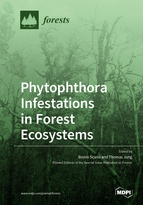Phytophthora Infestations in Forest Ecosystems
A special issue of Forests (ISSN 1999-4907). This special issue belongs to the section "Forest Ecophysiology and Biology".
Deadline for manuscript submissions: closed (30 June 2020) | Viewed by 46329
Special Issue Editors
Interests: forest pathology; diversity, biology and taxonomy of fungal pathogens and oomycetes
Special Issues, Collections and Topics in MDPI journals
Interests: diversity, biogeography, ecology, pathology and evolution of Phytophthora species; their impacts on natural and semi-natural ecosystems; their pathways and possible management and control options for Phytophthora diseases
Special Issues, Collections and Topics in MDPI journals
Special Issue Information
Dear Colleagues,
The oomycete genus Phytophthora represents one of the most notorious groups of tree pathogens in natural and semi-natural forest ecosystems. Since the discovery in the 1960s of the invasive P. cinnamomi, threatening some of the world’s richest plant communities in Australia, numerous Phytophthora diseases have been reported on forest trees worldwide which were previously unknown to science. The most notable examples include the oak and beech declines triggered by different Phytophthora spp. in Europe and North America, the finding of ‘Sudden Oak Death’ and ‘Sudden Larch Death’ caused by P. ramorum in the Western USA and the UK, respectively, and the association of P. austrocedri with the ‘mal del ciprés’ in Argentina and juniper decline in the UK. All these epidemic events are driven by exotic invasive Phytophthora species, introduced through infested nursery plants from their native overseas environments. In recent years, many independent surveys have studied the diversity of Phytophthora species and the diseases they are causing across a diverse range of forests and other natural ecosystems. This Special Issue is presenting papers on Phytophthora surveys performed in different biogeographic regions and addresses the pathways, and ecological and economic impacts of these invasive forest pathogens, and possible control strategies.
Dr. Bruno Scanu
Dr. Thomas Jung
Guest Editors
Manuscript Submission Information
Manuscripts should be submitted online at www.mdpi.com by registering and logging in to this website. Once you are registered, click here to go to the submission form. Manuscripts can be submitted until the deadline. All submissions that pass pre-check are peer-reviewed. Accepted papers will be published continuously in the journal (as soon as accepted) and will be listed together on the special issue website. Research articles, review articles as well as short communications are invited. For planned papers, a title and short abstract (about 100 words) can be sent to the Editorial Office for announcement on this website.
Submitted manuscripts should not have been published previously, nor be under consideration for publication elsewhere (except conference proceedings papers). All manuscripts are thoroughly refereed through a single-blind peer-review process. A guide for authors and other relevant information for submission of manuscripts is available on the Instructions for Authors page. Forests is an international peer-reviewed open access monthly journal published by MDPI.
Please visit the Instructions for Authors page before submitting a manuscript. The Article Processing Charge (APC) for publication in this open access journal is 2600 CHF (Swiss Francs). Submitted papers should be well formatted and use good English. Authors may use MDPI's English editing service prior to publication or during author revisions.
Keywords
- Epidemic
- Forest decline
- Invasive pathogens
- Oomycetes
- Root rot






